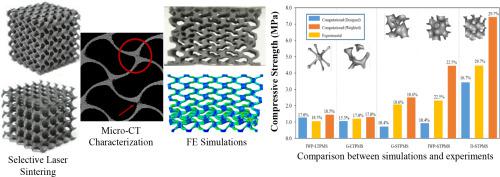当前位置:
X-MOL 学术
›
Mater. Des.
›
论文详情
Our official English website, www.x-mol.net, welcomes your
feedback! (Note: you will need to create a separate account there.)
Mechanical behavior of polymeric selective laser sintered ligament and sheet based lattices of triply periodic minimal surface architectures
Materials & Design ( IF 7.6 ) Pub Date : 2020-11-01 , DOI: 10.1016/j.matdes.2020.109100 Aliaa M. Abou-Ali , Oraib Al-Ketan , Dong-Wook Lee , Reza Rowshan , Rashid K. Abu Al-Rub
Materials & Design ( IF 7.6 ) Pub Date : 2020-11-01 , DOI: 10.1016/j.matdes.2020.109100 Aliaa M. Abou-Ali , Oraib Al-Ketan , Dong-Wook Lee , Reza Rowshan , Rashid K. Abu Al-Rub

|
Abstract Advances in additive manufacturing triggered a paradigm shift in the design of functional components allowing for complex topology-driven cellular lattices to be incorporated for the aim of reducing weight, enhancing multi-functionality, and facilitating manufacturability. In this paper, the compressive mechanical behavior of different polymeric lattices based on triply periodic minimal surfaces (TPMS) are investigated both experimentally and computationally. The behavior of two classes of TPMS lattices are investigated; sheet- and ligament-based lattices. Samples are fabricated using the laser powder bed fusion technique, selective laser sintering, and characterized using micro-Computed Tomography (micro-CT) and Scanning Electron Microscopy (SEM). A finite-deformation hyperelastic-viscoplastic-damage constitutive model is calibrated and employed to capture the full compressive behavior of lattices. The computational results are compared to and validated against corresponding experimental results. Results show that sheet-based polymeric TPMS lattices exhibit a stretching-dominated mode of deformation and prove to have superior stiffness and strength as compared to TPMS ligament-based lattices. The numerical simulations are in good agreement with experimental results for ligament-based lattices while significant deviation from experimental results is observed for the sheet-based lattices which is attributed to uncertainty in measuring the actual relative density and relatively higher manufacturing defects.
中文翻译:

三重周期性最小表面结构的聚合物选择性激光烧结韧带和片基晶格的机械性能
摘要 增材制造的进步引发了功能组件设计的范式转变,允许将复杂的拓扑驱动的蜂窝晶格纳入其中,以减轻重量、增强多功能性和促进可制造性。在本文中,基于三重周期最小表面 (TPMS) 的不同聚合物晶格的压缩力学行为通过实验和计算进行了研究。研究了两类TPMS晶格的行为;基于片和韧带的晶格。样品是使用激光粉末床融合技术、选择性激光烧结制造的,并使用微计算机断层扫描 (micro-CT) 和扫描电子显微镜 (SEM) 进行表征。有限变形超弹-粘塑性-损伤本构模型被校准并用于捕捉晶格的完整压缩行为。计算结果与相应的实验结果进行比较和验证。结果表明,与基于 TPMS 韧带的晶格相比,基于片材的聚合物 TPMS 晶格表现出拉伸主导的变形模式,并证明具有优异的刚度和强度。数值模拟与基于韧带的晶格的实验结果非常一致,而对于基于片的晶格观察到与实验结果的显着偏差,这归因于测量实际相对密度的不确定性和相对较高的制造缺陷。计算结果与相应的实验结果进行比较和验证。结果表明,与基于 TPMS 韧带的晶格相比,基于片材的聚合物 TPMS 晶格表现出拉伸主导的变形模式,并证明具有优异的刚度和强度。数值模拟与基于韧带的晶格的实验结果非常一致,而对于基于片的晶格观察到与实验结果的显着偏差,这归因于测量实际相对密度的不确定性和相对较高的制造缺陷。计算结果与相应的实验结果进行比较和验证。结果表明,与基于 TPMS 韧带的晶格相比,基于片材的聚合物 TPMS 晶格表现出拉伸主导的变形模式,并证明具有优异的刚度和强度。数值模拟与基于韧带的晶格的实验结果非常一致,而对于基于片的晶格观察到与实验结果的显着偏差,这归因于测量实际相对密度的不确定性和相对较高的制造缺陷。结果表明,与基于 TPMS 韧带的晶格相比,基于片材的聚合物 TPMS 晶格表现出拉伸主导的变形模式,并证明具有优异的刚度和强度。数值模拟与基于韧带的晶格的实验结果非常一致,而对于基于片的晶格观察到与实验结果的显着偏差,这归因于测量实际相对密度的不确定性和相对较高的制造缺陷。结果表明,与基于 TPMS 韧带的晶格相比,基于片材的聚合物 TPMS 晶格表现出拉伸主导的变形模式,并证明具有优异的刚度和强度。数值模拟与基于韧带的晶格的实验结果非常一致,而对于基于片的晶格观察到与实验结果的显着偏差,这归因于测量实际相对密度的不确定性和相对较高的制造缺陷。
更新日期:2020-11-01
中文翻译:

三重周期性最小表面结构的聚合物选择性激光烧结韧带和片基晶格的机械性能
摘要 增材制造的进步引发了功能组件设计的范式转变,允许将复杂的拓扑驱动的蜂窝晶格纳入其中,以减轻重量、增强多功能性和促进可制造性。在本文中,基于三重周期最小表面 (TPMS) 的不同聚合物晶格的压缩力学行为通过实验和计算进行了研究。研究了两类TPMS晶格的行为;基于片和韧带的晶格。样品是使用激光粉末床融合技术、选择性激光烧结制造的,并使用微计算机断层扫描 (micro-CT) 和扫描电子显微镜 (SEM) 进行表征。有限变形超弹-粘塑性-损伤本构模型被校准并用于捕捉晶格的完整压缩行为。计算结果与相应的实验结果进行比较和验证。结果表明,与基于 TPMS 韧带的晶格相比,基于片材的聚合物 TPMS 晶格表现出拉伸主导的变形模式,并证明具有优异的刚度和强度。数值模拟与基于韧带的晶格的实验结果非常一致,而对于基于片的晶格观察到与实验结果的显着偏差,这归因于测量实际相对密度的不确定性和相对较高的制造缺陷。计算结果与相应的实验结果进行比较和验证。结果表明,与基于 TPMS 韧带的晶格相比,基于片材的聚合物 TPMS 晶格表现出拉伸主导的变形模式,并证明具有优异的刚度和强度。数值模拟与基于韧带的晶格的实验结果非常一致,而对于基于片的晶格观察到与实验结果的显着偏差,这归因于测量实际相对密度的不确定性和相对较高的制造缺陷。计算结果与相应的实验结果进行比较和验证。结果表明,与基于 TPMS 韧带的晶格相比,基于片材的聚合物 TPMS 晶格表现出拉伸主导的变形模式,并证明具有优异的刚度和强度。数值模拟与基于韧带的晶格的实验结果非常一致,而对于基于片的晶格观察到与实验结果的显着偏差,这归因于测量实际相对密度的不确定性和相对较高的制造缺陷。结果表明,与基于 TPMS 韧带的晶格相比,基于片材的聚合物 TPMS 晶格表现出拉伸主导的变形模式,并证明具有优异的刚度和强度。数值模拟与基于韧带的晶格的实验结果非常一致,而对于基于片的晶格观察到与实验结果的显着偏差,这归因于测量实际相对密度的不确定性和相对较高的制造缺陷。结果表明,与基于 TPMS 韧带的晶格相比,基于片材的聚合物 TPMS 晶格表现出拉伸主导的变形模式,并证明具有优异的刚度和强度。数值模拟与基于韧带的晶格的实验结果非常一致,而对于基于片的晶格观察到与实验结果的显着偏差,这归因于测量实际相对密度的不确定性和相对较高的制造缺陷。











































 京公网安备 11010802027423号
京公网安备 11010802027423号